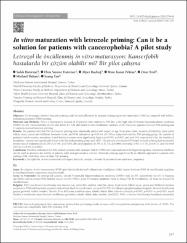| dc.contributor.author | Hatırnaz, Şafak | |
| dc.contributor.author | Saynur Hatırnaz, Ebru | |
| dc.contributor.author | Başbuğ, Alper | |
| dc.contributor.author | Kanat Pektaş, Mine | |
| dc.contributor.author | Erol, Onur | |
| dc.contributor.author | Dahan, Micheal H | |
| dc.contributor.author | Tan, Seang | |
| dc.date.accessioned | 2022-06-17T09:25:48Z | |
| dc.date.available | 2022-06-17T09:25:48Z | |
| dc.date.issued | 2020 | en_US |
| dc.identifier.citation | Hatırnaz, Ş., Hatırnaz, E. S., Başbuğ, A., Pektaş, M. K., Erol, O., Dahan, M., & Tan, S. (2020). In vitro maturation with letrozole priming: Can it be a solution for patients with cancerophobia? A pilot study. Turkish Journal of Obstetrics and Gynecology, 17(4), 247. | en_US |
| dc.identifier.issn | 2149-9330 | |
| dc.identifier.uri | https://doi.org/10.4274/tjod.galenos.2020.79446 | |
| dc.identifier.uri | https://hdl.handle.net/20.500.12933/1188 | |
| dc.description.abstract | Objective: To investigate whether letrozole priming could be used efficiently in patients undergoing in vitro maturation (IVM) as compared with follicle-stimulating hormone (FSH) priming. Materials and Methods: This is a retrospective analysis of 63 patients who underwent IVM due to the high risk of Ovarian Hyperstimulation syndrome (OHSS) (n=39), cancerophobia (n=16), and desire for IVM after failed in vitro fertilization attempts (n=8). Forty-two patients received FSH priming and 21 patients received letrozole priming. Results: The patients who had FSH or letrozole priming were statistically similar with respect to age, body mass index, duration of infertility, basal antral follicle count, serum anti-Müllerian hormone levels, and IVM indications (p>0.05 for all). When compared with the FSH priming group, the number of germinal vesicle oocytes, metaphase II and fertilized oocytes were significantly higher (p=0.003, p=0.001, and p=0.016, respectively), but the number of metaphase I oocytes was significantly lower in the letrozole priming group (p=0.002). The patients who received FSH and letrozole priming had statistically similar rates of implantation (33.3% vs 37.0%, p=0.709), clinical pregnancy (31.5% vs 33.3%, p=0.848), twinning (1.9% vs 3.7%, p=0.611), and live birth (24.1% vs 29.6%, p=0.682). Conclusion: Potential indications for IVM include patients with increased risk for OHSS and contraindication for hyperestrogenism. Aromatase inhibitors can be used to preserve the fertility of patients with estrogen-sensitive cancers. Letrozole priming appears to be an efficient approach in patients who undergo IVM, with likely less cost than FSH priming. | en_US |
| dc.language.iso | eng | en_US |
| dc.publisher | Turkish Society of Obstetrics and Gynecology | en_US |
| dc.relation.isversionof | 10.4274/tjod.galenos.2020.79446 | en_US |
| dc.rights | info:eu-repo/semantics/openAccess | en_US |
| dc.subject | Cancerphobia | en_US |
| dc.subject | In vitro maturation techniques | en_US |
| dc.subject | Letrozole | en_US |
| dc.subject | Oocytes | en_US |
| dc.subject | Ovarian Hyperstimulation syndrome | en_US |
| dc.subject | Pregnancy | en_US |
| dc.title | In vitro maturation with letrozole priming: Can it be a solution for patients with cancerophobia? A pilot study | en_US |
| dc.title.alternative | Letrozol ile öncüllenmiş in vitro maturasyon: Kanserfobik hastalarda bir çözüm olabilir mi? Bir pilot çalışma | en_US |
| dc.type | article | en_US |
| dc.authorid | 0000-0003-2862-3288 | en_US |
| dc.department | AFSÜ, Tıp Fakültesi, Cerrahi Tıp Bilimleri Bölümü, Kadın Hastalıkları ve Doğum Ana Bilim Dalı | en_US |
| dc.contributor.institutionauthor | Kanat Pektaş, Mine | |
| dc.identifier.volume | 17 | en_US |
| dc.identifier.issue | 4 | en_US |
| dc.identifier.startpage | 247 | en_US |
| dc.identifier.endpage | 252 | en_US |
| dc.relation.journal | Turkish Journal of Obstetrics and Gynecology | en_US |
| dc.relation.publicationcategory | Makale - Uluslararası Hakemli Dergi - Kurum Öğretim Elemanı | en_US |
















